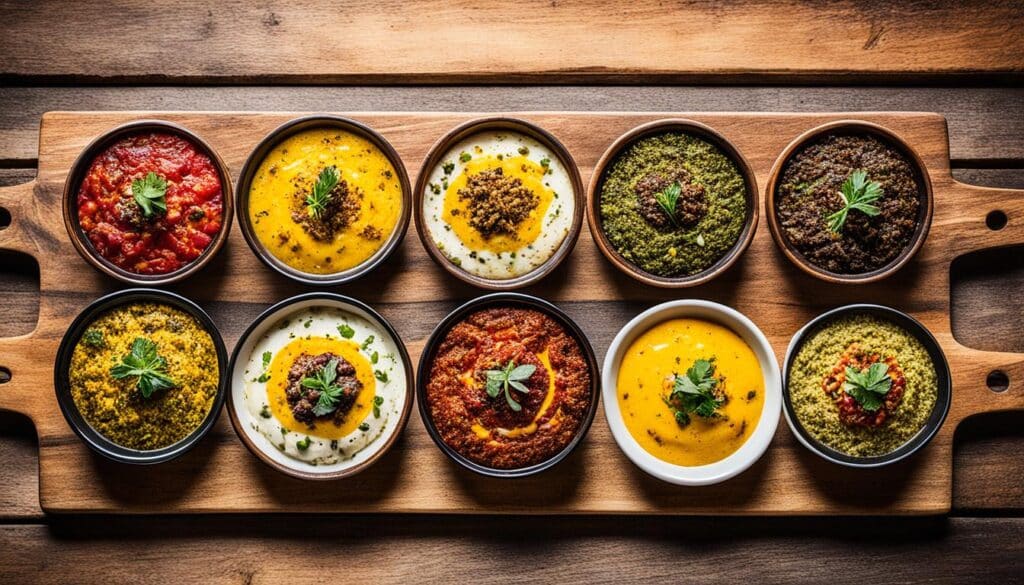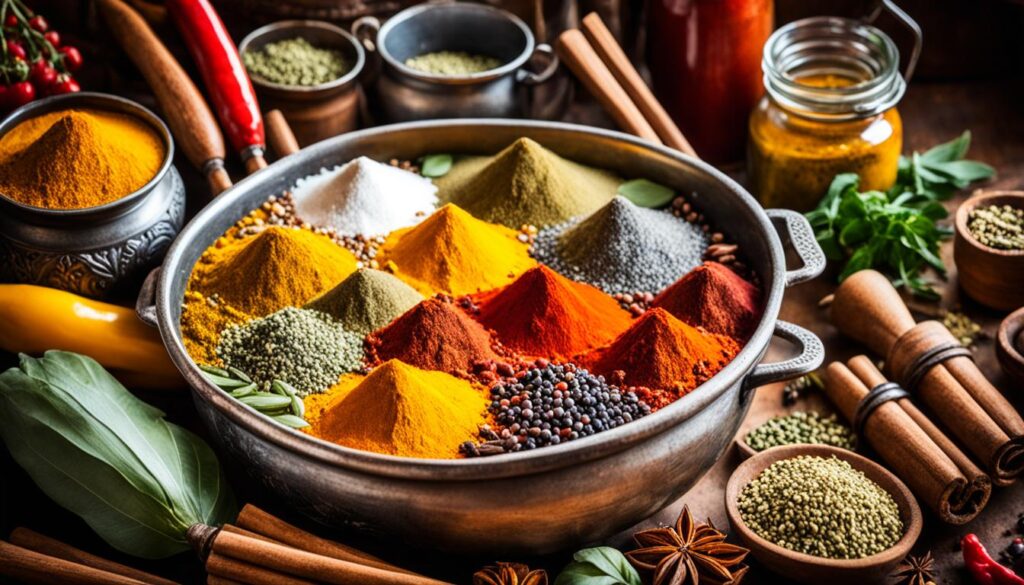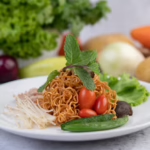In this article, we will delve into the flavorsome world of South African Bobotie, a beloved dish that holds a significant place in the country’s culinary heritage. Join us as we uncover the unique combination of spices, minced meat, and a delightful custard topping that make this dish a true delight for the senses.
Key Takeaways:
- South African Bobotie is a dish that showcases the country’s rich culinary heritage.
- It is a unique blend of spices, minced meat, and a creamy custard topping.
- Bobotie originated from the intersection of African, Asian, and European cuisines, particularly influenced by the Cape Malay community.
- It is considered a national dish of South Africa and is enjoyed by both locals and visitors.
- Traditionally served with yellow rice and green beans, Bobotie offers a delicious and satisfying dining experience.
The History of South African Bobotie
South African Bobotie is a dish that carries a fascinating history dating back to the 17th century. Its origins can be traced to the diverse culinary influences of South Africa, particularly the Cape Malay community. This unique intersection of African, Asian, and European cuisines has played a significant role in shaping the flavors and traditions surrounding Bobotie.
During the 17th century, the Dutch East India Company established a settlement at Cape Colony (modern-day Cape Town), bringing with them an array of spices and culinary traditions from their colonies in Asia. As they encountered Africa’s indigenous ingredients and cooking techniques, a fusion of flavors began to emerge.
The Cape Malay community, which consisted of enslaved individuals from present-day Indonesia and Malaysia, played a crucial role in the development of Bobotie. They infused their own culinary traditions and techniques, resulting in a unique blend of spices and flavors that still define Bobotie today.
Over time, the dish gained popularity and became ingrained in South African culture. Today, Bobotie is widely regarded as a national dish, cherished for its rich history and cultural significance. It is a testament to the country’s multicultural heritage and a symbol of the diverse flavors that can be found in South African cuisine.
Traditional South African Bobotie Recipe
To make authentic South African Bobotie, you will need a blend of aromatic spices such as curry powder, turmeric, and cumin. The dish typically features minced meat, often ground beef, mixed with a medley of flavors including apricot jam or chutney. The result is a tantalizing meat mixture that forms the base of this delicious dish.
If you’re ready to embark on a culinary adventure and recreate this beloved South African dish in your own kitchen, follow this traditional Bobotie recipe:
Ingredients:
- 500g minced meat (ground beef or lamb)
- 1 onion, finely chopped
- 2 cloves of garlic, minced
- 2 slices of white bread
- 1 cup milk
- 2 tablespoons curry powder
- 1 teaspoon turmeric
- 1 teaspoon ground cumin
- 2 tablespoons apricot jam
- 2 tablespoons chutney
- 1 tablespoon vegetable oil
- Salt and pepper to taste
Instructions:
- Preheat the oven to 180°C (350°F) and butter a medium-sized baking dish.
- In a bowl, soak the bread in milk until it becomes soft.
- Squeeze out the excess milk from the soaked bread and crumble it into a separate bowl.
- In a large pan, heat the vegetable oil over medium heat.
- Add the chopped onions and minced garlic to the pan and sauté until they become translucent.
- Add the minced meat to the pan and cook until browned.
- Stir in the curry powder, turmeric, and ground cumin, mixing well to coat the meat with the spices.
- Season the meat mixture with salt and pepper to taste.
- Add the crumbled bread, apricot jam, and chutney to the pan, stirring until well combined.
- Transfer the meat mixture to the buttered baking dish.
- In a separate bowl, beat the eggs and milk together to create the custard topping.
- Pour the custard over the meat mixture, ensuring it covers the entire surface.
- Bake in the preheated oven for approximately 40 minutes, or until the custard is set and golden brown.
Serve the Bobotie hot, accompanied by yellow rice, green beans, and a dollop of mango chutney. The combination of flavors and textures is sure to transport your taste buds to the vibrant world of South African cuisine.
Tantalize your senses with the tantalizing blend of flavors in this traditional South African Bobotie recipe. It’s time to bring a taste of South Africa to your table and savor the rich culinary heritage of this beloved dish.

The Signature Bobotie Topping
What sets South African Bobotie apart is its unique custard topping. A mixture of eggs and milk creates a creamy and velvety custard that is poured over the meat mixture. This topping adds a touch of richness and elevates the dish to new heights of flavor. The custard forms a golden crust while cooking, giving the Bobotie its distinctive appearance.
The custard topping is one of the defining elements of Bobotie, creating a harmonious combination of savory and sweet flavors. Made with simple ingredients, the custard provides a luxurious texture that complements the spiced meat perfectly. As the Bobotie cooks, the custard sets and forms a beautiful golden crust, adding visual appeal to the dish.
The unique custard topping is made by whisking together beaten eggs and milk. The ratio of eggs to milk can vary depending on personal preference, but a typical Bobotie custard is made with a equal parts milk and eggs. This mixture is then poured over the meat mixture, creating a creamy layer that infuses the dish with a luscious richness.
The custard topping not only adds a delightful creaminess to the Bobotie but also serves to balance out the spices in the meat. The eggs and milk meld with the flavorful spices and create a harmonious blend of tastes. It also helps to keep the meat moist during the cooking process, ensuring each bite is tender and succulent.
When the Bobotie is baked, the custard topping transforms into a delectable golden crust, enhancing the overall presentation of the dish. This crust provides a delightful contrast to the savory meat filling and adds a touch of elegance to the finished Bobotie.
The combination of the custard topping, aromatic spices, and well-seasoned meat creates a truly unique culinary experience. South African Bobotie stands out for its innovative use of a custard topping, elevating it from a simple meatloaf to a dish that is enjoyed by people all over the world.
The Art of Making Bobotie
Making Bobotie is a culinary journey that involves a series of careful steps to achieve the perfect balance of flavors. Each ingredient plays a crucial role in creating the harmonious taste that characterizes this beloved South African dish.
Key Steps in Making Bobotie:
- Soak the bread: Begin by soaking bread in milk, allowing it to absorb the liquid completely. This will help to add moisture and texture to the final dish.
- Squeeze the milk: Once the bread is soaked, gently squeeze out the excess milk, ensuring that the bread remains moist but not dripping.
- Add the bread to the meat mixture: Combine the soaked bread with a flavorful meat mixture in a mixing bowl. Mix well to ensure that the bread is evenly distributed throughout the meat.
- Cook until soft: Sauté onions and garlic in a pan until they are fragrant and translucent. Add the beef to the pan and cook until it is soft and cooked through. This step is crucial in developing the rich and savory flavors of the dish.
- Stir well: Stir the cooked beef mixture, ensuring that all the ingredients are thoroughly combined. This will help to integrate the flavors and create a cohesive filling for the Bobotie.
By following these steps, you can create a tender and flavorful Bobotie that will tantalize your taste buds.

The Perfect Side Dishes for Bobotie
When it comes to enjoying a traditional South African Bobotie, choosing the right side dishes can elevate the dining experience to new heights. Two classic accompaniments that complement this flavorful dish perfectly are yellow rice and green beans.
Yellow rice, with its vibrant golden hue, is a staple side dish that beautifully contrasts the rich and aromatic flavors of Bobotie. Made with fragrant spices such as turmeric, it adds a subtle warmth to each bite, enhancing the overall taste sensation.
As for green beans, their crisp texture and fresh flavor provide a refreshing balance to the spiciness of Bobotie. Whether steamed, sautéed, or stir-fried, green beans bring a vibrant burst of color and a delightful crunch to the meal.
By pairing Bobotie with these traditional South African side dishes, you create a harmonious culinary experience that combines the savory richness of the main dish with the comforting simplicity of the sides.
Try this pairing idea:
Delight your taste buds with a plate of tender and flavorful Bobotie, served alongside a generous scoop of yellow rice and a vibrant portion of sautéed green beans. The fragrant spices, aromatic meat, and creamy custard of the Bobotie are beautifully balanced by the vibrant colors and fresh flavors of the sides. Every bite is a celebration of the rich culinary heritage of South Africa.
Now that we have explored the perfect side dishes for Bobotie, let’s move on to exploring the different variations of this beloved South African dish.
| Side Dishes for Bobotie | Description |
|---|---|
| Yellow rice | A flavorful and vibrant rice dish made with aromatic spices, such as turmeric, that beautifully complements the flavors of Bobotie. |
| Green beans | Crunchy and fresh green beans, whether sautéed, steamed, or stir-fried, provide a refreshing contrast to the savory richness of Bobotie. |
Variations of Bobotie
While the traditional Bobotie recipe remains popular, there are different versions of this beloved South African dish that offer unique culinary experiences. These variations incorporate diverse ingredients and flavors, showcasing the versatility of Bobotie.
Moussaka-Inspired Bobotie
One exciting twist on Bobotie takes inspiration from the Greek dish moussaka. This version combines the traditional meat mixture with layers of eggplant or potato, creating a harmonious fusion of flavors. The addition of spices such as ground cumin and curry transforms the dish into a tantalizing curry-flavored meat dish.
Lentil Bobotie
For those seeking a vegetarian alternative, lentil Bobotie offers a delicious and nutritious option. Lentils are cooked until tender and mixed with a medley of spices and herbs, creating a flavorful and protein-packed filling. The lentil Bobotie is often accompanied by dried fruit, adding a delightful burst of sweetness to every bite.
| Version of Bobotie | Key Ingredients | Flavor Profile |
|---|---|---|
| Moussaka-Inspired Bobotie | Minced meat, eggplant or potato, ground cumin, curry spices | Curry-flavored, with layers of eggplant or potato |
| Lentil Bobotie | Lentils, spices, dried fruit | Savory and sweet, with a hint of natural sweetness from dried fruit |
These variations of Bobotie offer a delightful departure from the traditional recipe, showcasing the adaptability of this beloved South African dish. Whether you prefer the warm spices of the curry-flavored moussaka-inspired Bobotie or the heartiness of lentil Bobotie accompanied by dried fruit, there is a version to suit every palate.

Serving and Enjoying Bobotie
Bobotie, the traditional South African dish, is best enjoyed as a main course alongside a selection of side dishes and condiments. The combination of flavors and textures creates an unforgettable dining experience that truly showcases the soul of South African cuisine.
Side Dishes
When serving Bobotie, it is customary to include side dishes that complement the dish’s robust flavors. Here are some popular options:
- Yellow Rice: This fragrant and flavorful rice is a staple accompaniment to Bobotie. Its golden hue and subtle spices provide a pleasing contrast to the rich meat mixture.
- Green Beans: These crisp and vibrant vegetables add freshness to the meal, balancing out the richness of the Bobotie. They provide a satisfying crunch and a vibrant burst of color to the plate.
Condiments
Enhance the taste of Bobotie by adding condiments that complement its unique flavors. Here are two popular choices:
- Mango Chutney: The sweet and tangy flavors of mango chutney perfectly complement the savory nature of Bobotie. Its refreshing taste adds another layer of complexity to each bite.
- Apricot Jam: The subtle sweetness of apricot jam pairs beautifully with the spices in Bobotie, enhancing the overall flavor profile. Its velvety texture and fruity notes add a delightful touch to the dish.
By serving Bobotie with yellow rice, green beans, and a choice of condiments such as mango chutney or apricot jam, you can create a well-rounded meal that fully brings out the best in this traditional South African dish.
“Bobotie is a harmonious blend of flavors, and the addition of side dishes and condiments elevates it to a truly exceptional culinary experience.”

| Side Dishes | Condiments |
|---|---|
| Yellow Rice | Mango Chutney |
| Green Beans | Apricot Jam |
Exploring South African Cuisine
When it comes to culinary delights, South Africa offers a treasure trove of flavors and recipes that are sure to tantalize your taste buds. African cuisine, with its vibrant and diverse flavors, is a testament to the country’s rich history and multicultural heritage. From heartwarming stews to aromatic curries, South African cuisine is a journey of culinary exploration that will leave you craving for more.
One of the highlights of South African cuisine is its ability to blend traditional African flavors with influences from various cultures. This fusion creates a culinary tapestry that reflects the country’s diverse population and history. African recipes have been shaped by centuries of cultural exchanges, resulting in unique dishes that are both comforting and exciting.
South African cuisine is known for its use of aromatic spices, such as coriander, cardamom, and cloves, which infuse dishes with rich and complex flavors. These spices are often paired with local ingredients like maize, sweet potatoes, and indigenous meats to create dishes that are distinctly South African.
One popular South African dish is boerewors, a type of sausage made from coarsely minced beef, pork, or lamb, seasoned with a blend of spices and cooked over an open flame. Another classic is pap and vleis, a hearty meal consisting of maize porridge topped with tender meat, often served with a flavorful tomato and onion relish.
The diversity of South African cuisine allows for a range of delicious regional dishes to be explored and savored. From the spicy and flavorful Bunny Chow of Durban to the rich and creamy Cape Malay curries, each region offers its own unique culinary treasures.
South African cuisine is not just about the main dishes. The country is also famous for its delicious desserts, such as koeksisters (syrupy, twisted pastries), Milk Tart (a creamy custard tart), and Malva Pudding (a warm, sticky sponge cake served with custard or cream).
Regional Influences in South African Cuisine
The regional influences on South African cuisine are varied and have contributed to its diverse flavors. The Cape Malay community, descendants of Malay slaves brought to South Africa by the Dutch in the 17th century, have had a significant impact on the cuisine of the Western Cape. Their culinary traditions, characterized by the use of aromatic spices and unique flavor combinations, have become an integral part of South African cuisine.
The cuisine of the Zulu, Xhosa, and other ethnic groups is also influential, with staple foods such as maize and sorghum featuring prominently in their dishes. The mutual exchange of culinary practices between different ethnic communities has resulted in a culinary landscape that is both diverse and dynamic.
| Region | Dishes |
|---|---|
| Cape Malay | Cape Malay Curry, Bobotie, Koeksisters |
| Eastern Cape | Umngqusho (samp and beans), Potjiekos (slow-cooked stew) |
| KwaZulu-Natal | Bunny Chow, Durban Curry, Flame-Grilled Braai |
| Gauteng | Pap and Vleis, Vetkoek (deep-fried dough), Malva Pudding |
| Western Cape | Snoek Braai, Bobotie, Smoorsnoek |
Exploring South African cuisine is not just about tasting the dishes, but also immersing yourself in the country’s rich cultural heritage. It’s an opportunity to experience the warmth and hospitality of the locals, who take great pride in their culinary traditions. So, whether you’re indulging in a fragrant curry or savoring a traditional South African recipe, each bite will transport you to the vibrant heart of this incredible country.
Rediscovering South African Bobotie at Home
If you’re looking to recreate the authentic flavors of South African Bobotie in your own kitchen, we’ve got you covered. Our best Bobotie recipe features all the essential ingredients, including ground beef, dried apricots, raisins, and bay leaves.
To start, prepare the meatloaf base by combining ground beef, finely chopped dried apricots, and raisins. Season the mixture with a blend of aromatic spices, such as curry powder, cumin, salt, and pepper. These spices add an unmistakable South African flair to the dish.
Next, shape the meatloaf mixture into a loaf shape and place it in a baking dish. Insert bay leaves into the top of the meatloaf to infuse it with their unique fragrance and flavor.
For the custard topping, beat together eggs and milk until well combined. This custard will add a creamy and golden finish to the Bobotie.
Also Read:- Global Gastronomy: Exploring The Rich Tapestry Of International Cuisine
Pour the custard over the meatloaf, ensuring it covers the entire surface. The custard will seep into the meat mixture as it bakes, creating a luscious blend of flavors.
Bake the Bobotie in the center of your oven at 350°F (180°C) for approximately 45-60 minutes, or until the custard is set and the top is golden brown.
Once cooked, remove the Bobotie from the oven and let it rest for a few minutes before serving. This allows the flavors to meld together and ensures a moist and tender meatloaf.
To serve, slice the Bobotie and arrange it on a platter. Garnish with fresh herbs for added visual appeal. Traditional accompaniments like yellow rice and green beans pair perfectly with this classic South African dish.
So why not bring a taste of South Africa to your own kitchen? Follow our step-by-step instructions and savor the rich and hearty flavors of the best South African Bobotie recipe.
Conclusion
In conclusion, South African Bobotie is a true culinary gem that showcases the rich history and cultural diversity of South Africa. With its aromatic blend of spices, flavorful minced meat, and luscious custard topping, Bobotie offers a unique and satisfying dining experience. Whether you’re delving into the Cape Malay culinary tradition or simply looking to explore new flavors, this dish is sure to tantalize your taste buds.
As a national dish, Bobotie holds a special place in South African hearts. It represents the fusion of African, Asian, and European influences dating back to the 17th century. The dish’s distinctive flavors and techniques have been passed down through generations, making it a beloved part of the country’s gastronomic heritage.
Whether you’re enjoying Bobotie at home or in a traditional South African restaurant, the flavors and textures of this dish are sure to leave a lasting impression. So indulge your senses and savor the flavors of South Africa with a mouthwatering serving of Bobotie, a true culinary masterpiece.
FAQ
What is South African Bobotie?
South African Bobotie is a traditional dish that is often referred to as the national dish of South Africa. It is a curry-flavored meat dish made with ground beef seasoned with a mix of spices such as curry powder, turmeric, and cumin. The meat mixture is then topped with a unique custard made from eggs and milk, which gives it a creamy and velvety texture.
How do I make Bobotie?
To make Bobotie, you will first need to soak bread in milk, squeeze out the excess liquid, and add it to the meat mixture. Mix well to ensure even distribution of flavors. Sauté onions and garlic in butter, then add the beef and cook until soft. Stir well to combine the ingredients. Lastly, prepare the custard topping by mixing eggs and milk, then pour it over the meat mixture. Bake until the custard forms a golden crust.
What are some traditional side dishes to serve with Bobotie?
Traditional side dishes to serve with Bobotie include yellow rice and green beans. The yellow rice complements the flavors of the dish perfectly, while the green beans add freshness and balance to the meal. These side dishes are often enjoyed alongside the Bobotie to enhance the overall dining experience.
Can I customize the Bobotie recipe?
Yes, you can customize the Bobotie recipe to suit your preferences. Some variations of Bobotie may incorporate lentils or dried fruit for added texture and flavor. You can also add your own twist by using different combinations of spices or ingredients inspired by other dishes like moussaka. The key is to experiment and create a version that best suits your taste.
How should I serve and enjoy Bobotie?
Bobotie is typically served as a main course. It is best enjoyed with traditional South African accompaniments such as yellow rice, green beans, and condiments like mango chutney or apricot jam. The combination of flavors and contrasting textures makes for a memorable dining experience. Whether enjoyed at home or in a traditional South African restaurant, Bobotie is a dish that represents the soul of South African cuisine.



